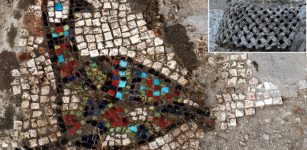America’s Oldest City Caral Illegally Invaded And Archaeologist Threatened With Death
Jan Bartek - AncientPages.com - Sacred city of Caral is America’s oldest archaeological site. Pre-dating the Inca empire by 45 centuries, this magnificent place has survived for 5,000 years, but how much longer will this UNESCO World Heritage site withstand destructive people?
“Sacred City of Caral is very old and its age is comparable to the early civilizations of Mesopotamia, Egypt, China, and Mesoamerica.
Impressive pyramids that rise high above the ground, a sunken circular plaza, an amazing amphitheater, and public gathering places make the ruins of Caral very special.
Ancient city of Caral. Credit: Peru Travel
The pyramids of Caral were built as early as about 2600 BC. The construction of these buildings is estimated to have continued until about 2000 BC. This makes them of age comparable to the Pyramids of Giza and Cheops in Egypt, built between 2600 and 2480 BC.” 1
The builders of Cara were peaceful people and scientists who examined the site have never found any evidence of warfare.
Unfortunately, hostility and violence are now surrounding Caral that is under threat from squatters claiming the coronavirus pandemic has left them with no other option but to occupy the sacred city.
“The situation has become so bad that archeologist Ruth Shady, who discovered the Caral site in Peru, has been threatened with death if she doesn't abandon investigating its treasures,” AFP reports.
According to archaeologists “squatter invasions and destruction began in March when the pandemic forced a nationwide lockdown.
"There are people who come and invade this site, which is state property, and they use it to plant," archeologist Daniel Mayta told AFP.
"It's hugely harmful because they're destroying 5,000-year-old cultural evidence."
The fact that Caral is America’s oldest site and plays a unique part in our cultural heritage is irrelevant to the squatters who refuse to leave.
During 107 days of lockdown people simply took advantage of minimal police surveillance. Once they entered and took control of the 10 hectares of the Chupacigarro archeological site they started planting avocados, fruit trees, and lima beans.
What is also very disturbing is that archaeologists have received numerous death threats.
“Shady is the director of the Caral archeological zone and has been managing the investigations since 1996 when excavations began.
She says that land traffickers—who occupy state or protected land illegally to sell it for private gain—are behind the invasions,” AFP reports.
"We're receiving threats from people who are taking advantage of the pandemic conditions to occupy archeological sites and invade them to establish huts and till the land with machinery ... they destroy everything they come across," said Shady.
"One day they called the lawyer who works with us and told him they were going to kill him with me and bury us five meters underground" if the archeological work continued at the site.
The City of Caral, located at km 182, north of Lima; in the Supe Valley. Credits: Turandino
The threats have forced Shady to live in Lima under protection.
She was given the Order of Merit by the government last week for services to the nation.
"We're doing what we can to ensure that neither your health nor your life are at risk due to the effects of the threats you're receiving," Peru's President Francisco Sagasti told her at the ceremony.
Closed due to the pandemic, Caral reopened to tourists in October and costs just $3 to visit.
During the lockdown, several archeological pieces were looted in the area and in July police arrested two people for partially destroying a site containing mummies and ceramics.
Caral has been investigated by archaeologists, but there are still unknown treasures hidden at the site. Not so long ago, Shady discovered an ancient relief was likely done towards the end of a drought and famine that the Caral civilization experienced.
The Caral inhabitants understood that they lived in seismic territory.
Their structures had baskets filled with stones at the base that cushioned the movement of the ground and prevented the construction from collapsing.
Will our modern civilization also prevent Caral from destruction?
Written by Jan Bartek - AncientPages.com Staff Writer
Expand for references





















